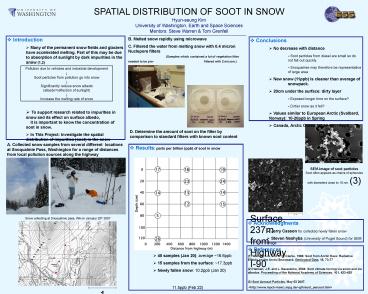SPATIAL DISTRIBUTION OF SOOT IN SNOW - PowerPoint PPT Presentation
1 / 1
Title: SPATIAL DISTRIBUTION OF SOOT IN SNOW
1
SPATIAL DISTRIBUTION OF SOOT IN SNOW Hyun-seung
Kim University of Washington, Earth and Space
Sciences Mentors Steve Warren Tom Grenfell
- Introduction
- Many of the permanent snow fields and glaciers
have accelerated melting. Part of this may be due
to absorption of sunlight by dark impurities in
the snow (1,2) - To support research related to impurities in
snow and its effect on surface albedo, it is
important to know the concentration of soot in
snow. - In This Project Investigate the spatial
distribution of impurities (soot) in the snow
- B. Melted snow rapidly using microwave
- C. Filtered the water from melting snow with 0.4
micron Nuclepore filters (Samples which
contained a lot of vegetation litter needed to be
pre- filtered with 2 micron.)
- Conclusions
- No decrease with distance
- - Soot particles from diesel are small so do not
fall out quickly. - - Snoqualmie may therefore be representative of
large area - New snow (11ppb) is cleaner than average of
snowpack. - 20cm under the surface dirty layer
- - Exposed longer time on the surface?
- - Dirtier snow as it fell?
- Values similar to European Arctic (Svalbard,
Norway) 10-20ppb in Spring - Canada, Arctic Ocean are lower 5ppb
D. Determine the amount of soot on the filter by
comparison to standard filters with known soot
content
A. Collected snow samples from several different
locations at Snoqualmie Pass, Washington for a
range of distances from local pollution sources
along the highway
- Results parts per billion (ppb) of soot in
snow
SEM-Image of soot particles Soot often appears as
chains of spherules with diameters close to 10
nm. (3)
Surface, 237m from Highway I-90
Snow collecting at Snoqualmie pass, WA on January
20th 2007
- Acknowledgments
- Jerry Casson for collected newly fallen snow
- Steven Neshyba (University of Puget Sound) for
SEM image
- References
- (1) Warren, S.G. and A. D. Clarke, 1986 Soot
from Arctic Haze Radiative Effects on the Arctic
Snowpack. Geological Data, 18, 73-77 - (2) Hansen, J.E. and L. Nazarenko, 2004 Soot
climate forcing via snow and ice albedos.
Proceeding of the National Academy of Sciences,
101, 423-428 - (3) Soot Aerosol Particles. May 03 2007.
- lthttp//www.mpch-mainz.mpg.de/gth/soot_aerosol.h
tmgt
- 40 samples (Jan 20) average 16.6ppb
- 15 samples from the surface 17.3ppb
- Newly fallen snow 10.2ppb (Jan 20)
- 11.5ppb (Feb 22)
- 10.7ppb (Feb 25)
1km































